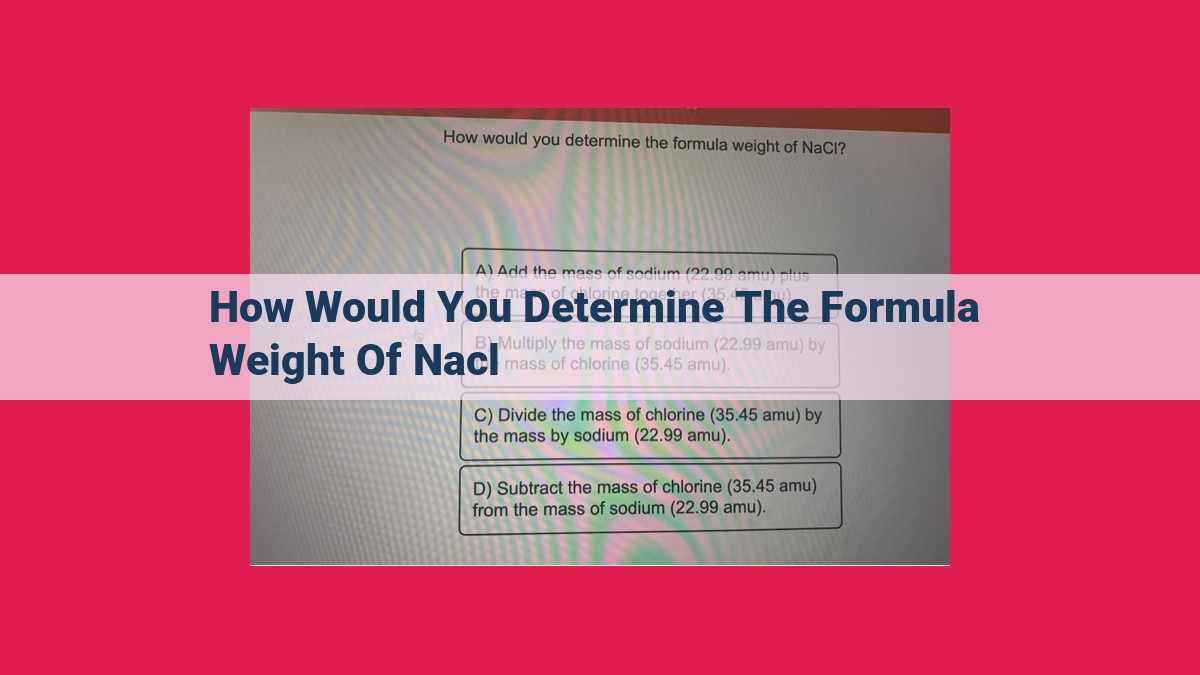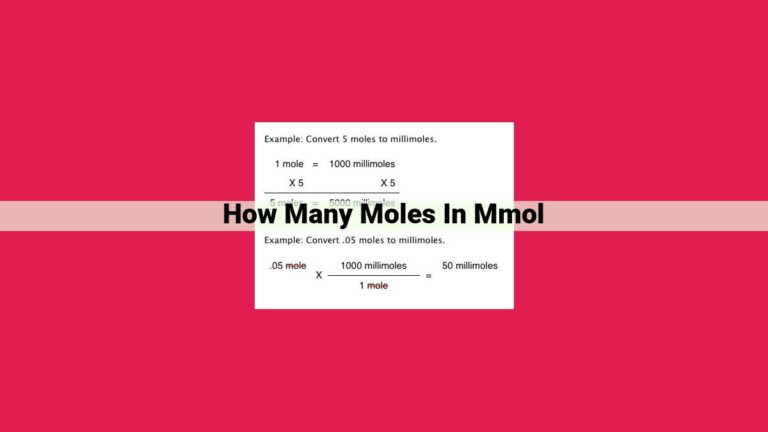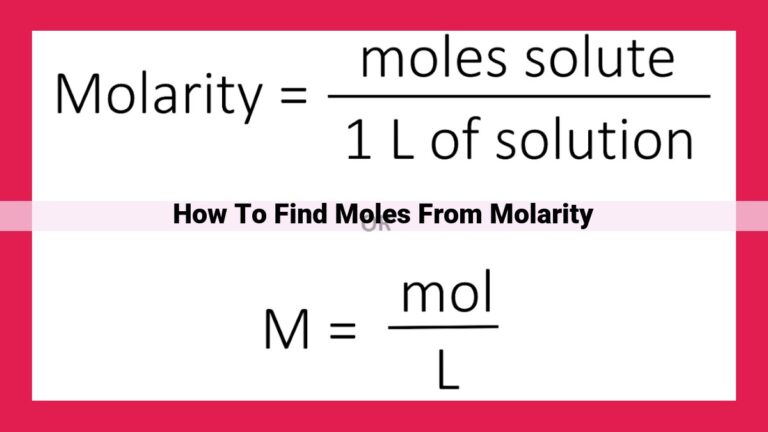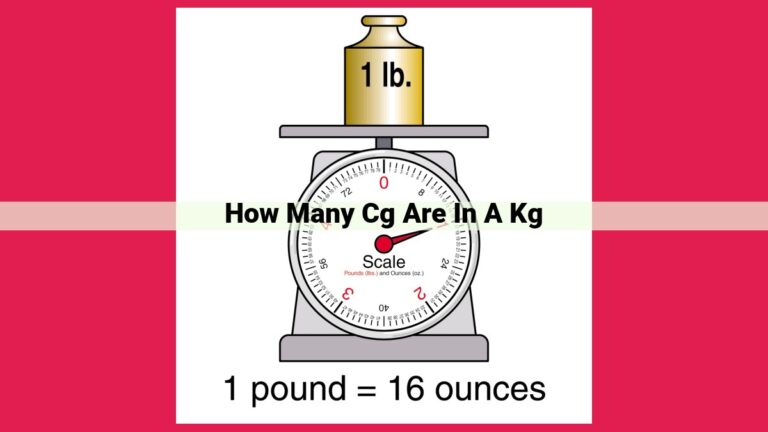Calculating The Formula Weight Of Nacl: A Comprehensive Guide

To determine the formula weight of NaCl, one must understand that it represents the combined mass of all atoms in its formula unit. The composition of NaCl reveals that it contains sodium and chlorine, and their respective atomic masses are used to calculate the molar mass of NaCl. Avogadro’s number provides the conversion between mass and particle count, ultimately enabling the calculation of the formula weight by summing the atomic masses of sodium and chlorine, resulting in the formula weight of NaCl.
Understanding Formula Weight
- Definition of formula weight, its significance, and calculation methods.
Understanding Formula Weight: The Cornerstone of Chemical Quantifications
In the realm of chemistry, understanding the concept of formula weight is crucial for comprehending the composition and properties of substances. It lays the foundation for deciphering the intricate relationships between the atomic constituents of molecules and their macroscopic characteristics.
Definition, Significance, and Calculation of Formula Weight
Formula weight, also known as molecular weight, is the sum of the atomic weights of all the atoms present in a molecular formula. It represents the mass per formula unit, which could be a molecule, an ionic compound, or an empirical formula. Accurate knowledge of formula weight enables chemists to:
- Determine the relative molecular mass of substances
- Calculate stoichiometric ratios in chemical reactions
- Understand the composition and properties of compounds
Calculating formula weight is a straightforward process:
- Determine the atomic weights of each element in the chemical formula.
- Multiply the atomic weight of each element by the number of atoms of that element present in the formula.
- Sum the products obtained in step 2.
The resulting value represents the formula weight in atomic mass units (amu) or grams per mole (g/mol).
Understanding the Composition of NaCl: A Journey into the World of Sodium Chloride
Step into the fascinating realm of chemistry, where we unravel the secrets of the compound known as NaCl. This ubiquitous substance, commonly known as table salt, plays a pivotal role in our daily lives. In this article, we embark on a scientific adventure to comprehend the composition of NaCl, delving into its chemical formula and elemental makeup.
Chemical Formula: A Key to Understanding NaCl
The chemical formula of NaCl, which stands for sodium chloride, reveals its molecular structure. It consists of one sodium (Na) atom and one chlorine (Cl) atom. This arrangement of atoms dictates the unique properties of NaCl.
Elemental Composition: Uncovering the Building Blocks
The elemental composition of NaCl provides insights into its composition by mass percentage. By using advanced analytical techniques, scientists have determined that NaCl contains 39.34% of sodium and 60.66% of chlorine. This information allows us to understand the relative proportions of these elements within the NaCl molecule.
Our exploration into the composition of NaCl has shed light on its chemical formula and elemental makeup. We now appreciate that NaCl is composed of sodium and chlorine atoms, with specific mass percentages. This knowledge forms the foundation for further investigations into the properties and applications of this versatile compound. As we continue our scientific journey, the secrets of NaCl will continue to unfold, enriching our understanding of the world around us.
Molar Mass of NaCl: Unraveling the Essence of Mass in Chemistry
In the realm of chemistry, understanding the molar mass is crucial for navigating the atomic and molecular world. Simply put, molar mass represents the mass of one mole of a substance, providing a bridge between the microscopic and macroscopic scales.
So, what is a mole, you may ask? A mole is a colossal number, approximately 6.022 x 10^23, akin to a staggering army of particles. It serves as a convenient unit for counting atoms, molecules, or ions. When dealing with compounds like NaCl, we use their formula weight to calculate their molar mass.
Formula weight is the sum of the atomic masses of all the elements present in a molecule. For NaCl, also known as sodium chloride, the formula weight is determined by adding the atomic mass of sodium (22.99 amu) to the atomic mass of chlorine (35.45 amu). This gives us a formula weight of 58.44 amu.
Next, we convert the formula weight into molar mass by multiplying it by the mole’s constant, Avogadro’s number (6.022 x 10^23 particles/mole). For NaCl, this calculation yields a molar mass of 58.44 grams per mole (g/mol).
This molar mass value provides invaluable information. It tells us that one mole of NaCl weighs 58.44 grams. It is like a universal scale that allows us to compare the masses of different substances, regardless of their chemical composition.
**Avogadro’s Number: The Bridge Between Particles and Mass**
In the realm of chemistry, Avogadro’s number stands as a pivotal concept, enabling us to navigate the vast expanse between the microscopic world of atoms and molecules and the tangible realm of observable matter. This remarkable number, approximately 6.022 x 1023, represents the extraordinary quantity of particles (atoms, molecules, ions, etc.) contained within one mole of a substance.
Its Significance in Chemistry
Avogadro’s number serves as a bridge between the particle level and the macroscopic scale. It allows us to convert between the number of particles and the mass or volume of a substance, providing a crucial tool for understanding chemical reactions and transformations. For instance, by knowing the molar mass of a compound and the number of moles present, we can determine the total mass or volume of the substance.
Calculating Formula Weight Using Avogadro’s Number
The formula weight of a compound, expressed in grams per mole, represents the mass of one mole of that compound. Avogadro’s number plays a vital role in calculating formula weight. By multiplying the atomic mass of each element in the compound by the number of atoms of that element and then summing these values, we obtain the formula weight in grams per mole.
Unveiling the Structure of NaCl
Let’s explore the composition of sodium chloride (NaCl), a ubiquitous compound commonly referred to as “table salt.” The chemical formula NaCl reveals that each molecule of sodium chloride consists of one atom of sodium (Na) and one atom of chlorine (Cl). By calculating the molar mass of NaCl using Avogadro’s number, we determine that one mole of NaCl weighs approximately 58.44 grams.
In essence, Avogadro’s number empowers us to delve into the atomic realm and comprehend the relationship between the number of particles and the mass or volume of matter. Armed with this knowledge, we gain a deeper understanding of chemical reactions, enabling us to decipher the intricate workings of our physical world.
Calculation of Formula Weight for NaCl
- Step-by-step process to calculate the formula weight of NaCl using atomic masses and its molecular formula.
Calculating the Formula Weight of NaCl: Unveiling the Composition of Salt
When it comes to understanding the composition of compounds like NaCl (sodium chloride), delving into the concept of formula weight is essential. Imagine yourself as a culinary chemist, carefully measuring the ingredients to create a perfect dish. In chemistry, formula weight plays a similar role, representing the combined mass of all atoms in a compound’s molecular formula.
In the case of NaCl, its molecular formula indicates that it’s composed of one sodium (Na) atom and one chlorine (Cl) atom. To calculate its formula weight, we need to know the atomic masses of these elements. From the periodic table, we find that the atomic mass of sodium is approximately 22.99 g/mol and that of chlorine is 35.45 g/mol.
Now, we simply add these atomic masses to determine the formula weight of NaCl:
Formula weight of NaCl = atomic mass of Na + atomic mass of Cl
= 22.99 g/mol + 35.45 g/mol
= 58.44 g/mol
Therefore, the formula weight of NaCl is 58.44 g/mol, indicating that each molecule of NaCl has a mass of 58.44 grams. This information is crucial for determining various properties of NaCl, such as its molar mass and its composition by mass percentage.




